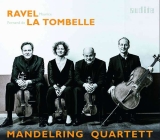 Maurice Ravel: Streichquartett F-Dur; Fernand de la Tombelle: Streichquartett E-Dur op. 36; Mandelring Quartett (Sebastian Schmidt, Violine, Nanette Schmidt, Violine, Andreas Willwohl, Viola, Bernhard Schmidt, Violoncello); 1 CD Audite 97.709; Aufnahme 10/2018, Veröffentlichung 09/04/2021 (57'13) – Rezension von Remy Franck
Maurice Ravel: Streichquartett F-Dur; Fernand de la Tombelle: Streichquartett E-Dur op. 36; Mandelring Quartett (Sebastian Schmidt, Violine, Nanette Schmidt, Violine, Andreas Willwohl, Viola, Bernhard Schmidt, Violoncello); 1 CD Audite 97.709; Aufnahme 10/2018, Veröffentlichung 09/04/2021 (57'13) – Rezension von Remy Franck

An spannenden Interpretationen des Streichquartetts von Maurice Ravel herrscht kein Mangel. Das Mandelring Quartett fügt nun eine weitere herausragende Einspielung hinzu. Die vier Streicher spüren die dramatischen Effekte auf und geben der Partitur die Spontaneität von Ravels Inspiration zurück. Einerseits ist die Interpretation von Glut, Inbrunst und spannungsgeladener, oft fiebriger Kraft geprägt, die das Beste aus jeder Note herausholt, andererseits fehlen auch Transparenz, Raffinesse und Sinnlichkeit nicht. Für mich ist dies eine der packendsten Interpretationen dieser Komposition, und sie straft alle die Lügen, die behaupten, das Quartett verkörpere nichts als Sinnlichkeit und Grazie.
Fernand de la Tombelle (1854-1928) hat an die 600 Werke hinterlassen. Der rührige Baron, der auch Pianist und Organist war, Schriftsteller, Photograph und Maler, Amateur-Astronom und anderes mehr, ist ein französischer Romantiker, der Kammermusik, Opern, Chormusik und Lieder komponiert hat.
Wie Ravel hat De la Tombelle nur ein Streichquartett komponiert, aber anders als bei Ravel gibt es kaum Aufnahmen davon und sicher keine herausragende.
Nun ändert sich die Lage. Das Mandelring Quartett steigt mit viel Schwung und lyrischem Elan in den ersten Satz ein und spielt das Scherzo ebenso tempo- wie kontrastreich. Darauf folgt ein emotionales Adagio, das zu einem Finalsatz führt, der eher ungeduldig und irritiert wirkt, um schließlich in wie fragend formuliert ruhigeren Passagen den Weg frei zu machen für eine hoch fliegende, unbeschwerte Coda. Damit hat das Tombelle-Quartett endlich eine werkgerechte Auferstehung mit Himmelfahrt geschafft.
There is no shortage of exciting interpretations of Maurice Ravel’s string quartets. The Mandelring now adds another outstanding recording. The four string players track down the dramatic effects and return to the score the spontaneity of Ravel’s inspiration. On the one hand, the interpretation is marked by fervor, ardor, and tense, often feverish power that brings out the best of every note; on the other hand, transparency, sophistication, and sensuality are not lacking. For me, this is one of the most gripping interpretations of this composition, and it gives the lie to all those who claim that the quartet embodies nothing but sensuality and grace.
Fernand de la Tombelle (1854-1928) left behind close to 600 works. The enterprising baron, who was also a pianist and organist, a writer, photographer and painter, amateur astronomer, and more, is a French romantic who composed chamber music, operas, choral music, and songs.
Like Ravel, de La Tombelle composed only one string quartet, but unlike Ravel, there are very few recordings of it and certainly none outstanding.
Now the situation is changing. With the Mandelring Quartet the first movement has a lot of verve and lyricism, the Scherzo is alert and contrasted. They are followed by an emotional Adagio that leads to a final movement that seems rather impatient and irritated, finally clearing the way for a high-flying, light-hearted coda. With this, the Tombelle Quartet has finally achieved of this work not only a beautiful resurrection but also a heavenly ascension.






















